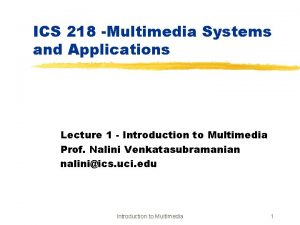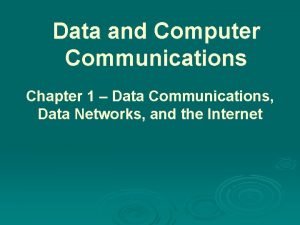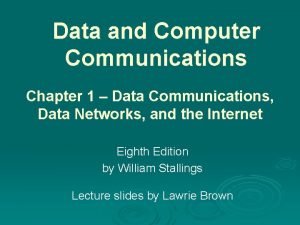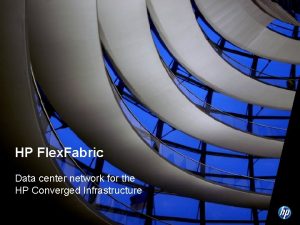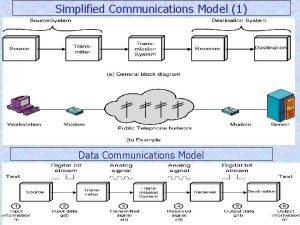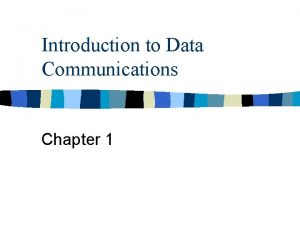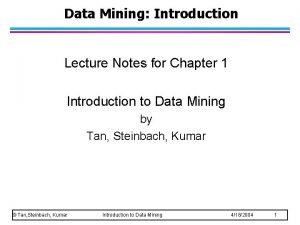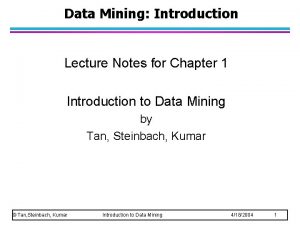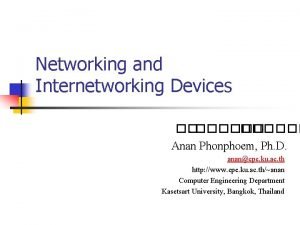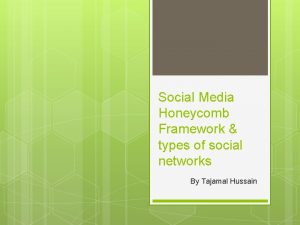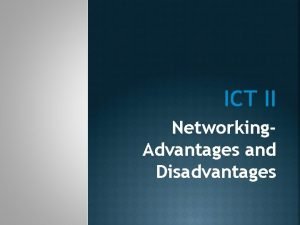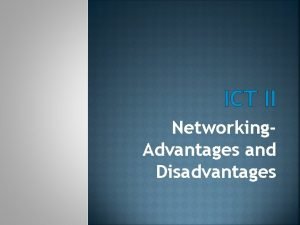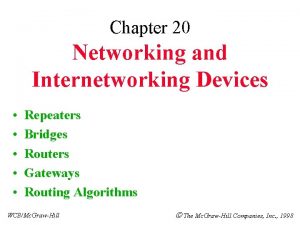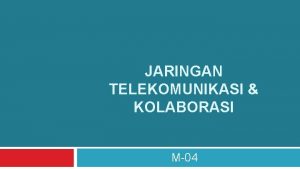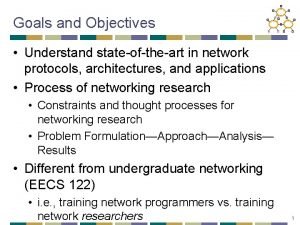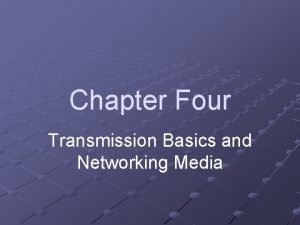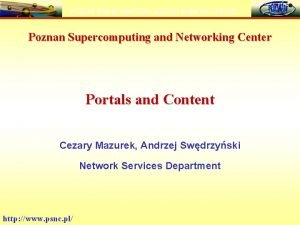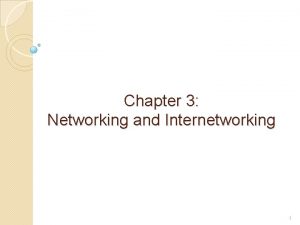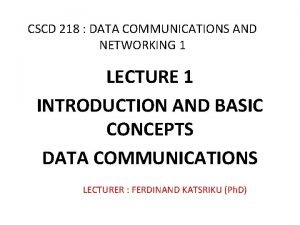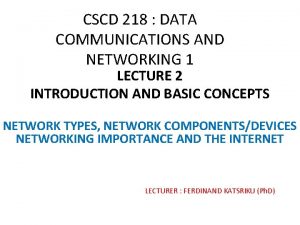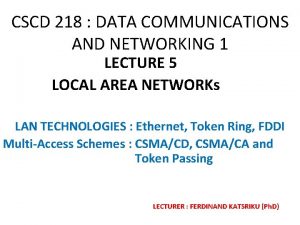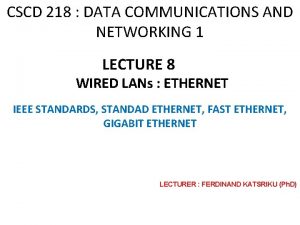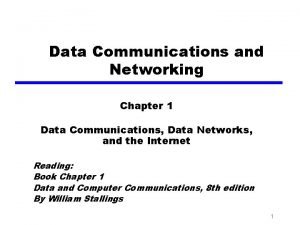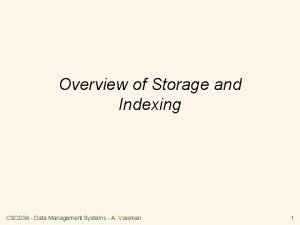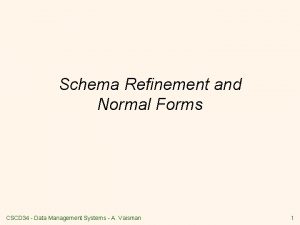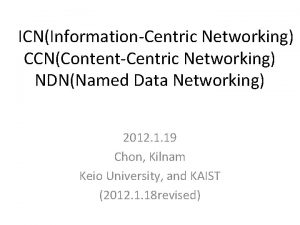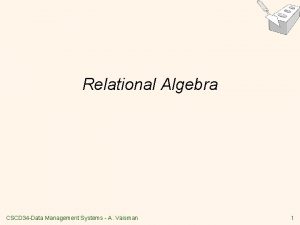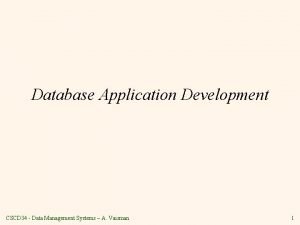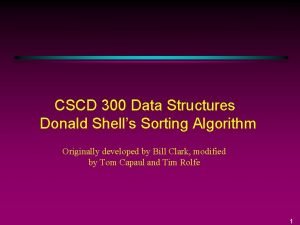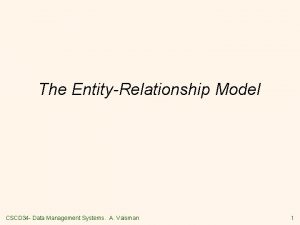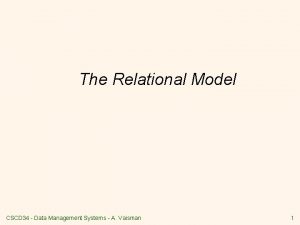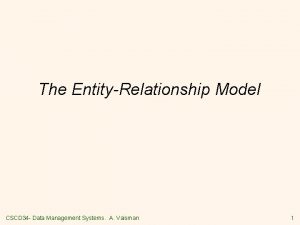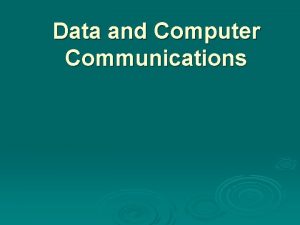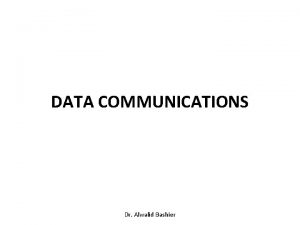CSCD 218 DATA COMMUNICATIONS AND NETWORKING 1 LECTURE













































- Slides: 45

CSCD 218 : DATA COMMUNICATIONS AND NETWORKING 1 LECTURE 12 OSI MODEL AND TCP/IP MODEL LAYERS OF OSI MODEL AND LAYERS OF TCP/IP MODEL LECTURER : FERDINAND KATSRIKU (Ph. D) TCP/IP Protocol Suite 1

OBJECTIVES: q To discuss the idea of multiple layering in data communication and networking and the interrelationship between layers. q To discuss the OSI model and its layer architecture and to show the interface between the layers. q To briefly discuss the functions of each layer in the OSI model. q To introduce the TCP/IP protocol suite and compare its layers with the ones in the OSI model. q To show the functionality of each layer in the TCP/IP protocol with some examples. q To discuss the addressing mechanism used in some layers of the TCP/IP protocol suite for the delivery of a message from the source to the destination. TCP/IP Protocol Suite 2

Chapter Outline 2. 1 Protocol Layers 2. 2 The OSI Model 2. 3 TCP/IP Protocol Suite 2. 4 Addressing TCP/IP Protocol Suite 3

2 -1 PROTOCOL LAYERS In Chapter 1, we discussed that a protocol is required when two entities need to communicate. When communication is not simple, we may divide the complex task of communication into several layers. In this case, we may need several protocols, one for each layer. Let us use a scenario in communication in which the role of protocol layering may be better understood. We use two examples. In the first example, communication is so simple that it can occur in only one layer. TCP/IP Protocol Suite 4

Topics Discussed in the Section üHierarchy üServices TCP/IP Protocol Suite 5

Example 2. 1 Assume Maria and Ann are neighbors with a lot of common ideas. However, Maria speaks only Spanish, and Ann speaks only English. Since both have learned the sign language in their childhood, they enjoy meeting in a cafe a couple of days per week and exchange their ideas using signs. Occasionally, they also use a bilingual dictionary. Communication is face to face and Happens in one layer as shown in Figure 2. 1. TCP/IP Protocol Suite 6

Figure 2. 1 TCP/IP Protocol Suite Example 2. 1 7

Example 2. 2 q We use the concept of layers in our daily life. As an example, let us consider two friends who communicate through postal mail. q The process of sending a letter to a friend would be complex if there were no services available from the post office. Figure 2. 1 shows the steps in this task. TCP/IP Protocol Suite 8

Figure 2. 2 TCP/IP Protocol Suite Example 2. 2 9

2 -2 THE OSI MODEL Established in 1947, the International Standards Organization (ISO) is a multinational body dedicated to worldwide agreement on international standards. Almost three-fourths of countries in the world are represented in the ISO. An ISO standard that covers all aspects of network communications is the Open Systems Interconnection (OSI) model. It was first introduced in the late 1970 s. TCP/IP Protocol Suite 10

Topics Discussed in the Section üLayered Architecture üLayer-to-layer Communication üEncapsulation üLayers in the OSI Model üSummary of OSI Layers TCP/IP Protocol Suite 11

Note ISO is the organization; OSI is the model. TCP/IP Protocol Suite 12

Figure 2. 3 TCP/IP Protocol Suite The OSI model 13

Figure 2. 4 TCP/IP Protocol Suite OSI layers 14

Figure 2. 5 TCP/IP Protocol Suite An exchange using the OSI model 15

Note The physical layer is responsible for moving individual bits from one (node) to the next. TCP/IP Protocol Suite 16

Figure 2. 6 TCP/IP Protocol Suite Summary of OSI Layers 17

2 -3 TCP/IP PROTOCOL SUITE The TCP/IP protocol suite was developed prior to the OSI model. Therefore, the layers in the TCP/IP protocol suite do not match exactly with those in the OSI model. The original TCP/IP protocol suite was defined as four software layers built upon the hardware. Today, however, TCP/IP is thought of as a five-layer model with the layers named similarly to the ones in the OSI model. Figure 2. 7 shows both configurations. TCP/IP Protocol Suite 18

Topics Discussed in the Section üComparison between OSI and TCP/IP üLayers in the TCP/IP Suite TCP/IP Protocol Suite 19

Figure 2. 7 TCP/IP Protocol Suite Layers in the TCP/IP Protocol Suite 20

Figure 2. 8 TCP/IP Protocol Suite TCP/IP and OSI model 21

Figure 2. 9 TCP/IP Protocol Suite A private internet 22

Figure 2. 10 TCP/IP Protocol Suite Communication at the physical layer 23

Note The unit of communication at the physical layer is a bit. TCP/IP Protocol Suite 24

Figure 2. 11 TCP/IP Protocol Suite Communication at the data link layer 25

Note The unit of communication at the data link layer is a frame. TCP/IP Protocol Suite 26

Figure 2. 12 TCP/IP Protocol Suite Communication at the network layer 27

Note The unit of communication at the network layer is a datagram. TCP/IP Protocol Suite 28

Figure 2. 13 TCP/IP Protocol Suite Communication at transport layer 29

Note The unit of communication at the transport layer is a segment, user datagram, or a packet, depending on the specific protocol used in this layer. TCP/IP Protocol Suite 30

Figure 2. 14 TCP/IP Protocol Suite Communication at application layer 31

Note The unit of communication at the application layer is a message. TCP/IP Protocol Suite 32

2 -4 ADDRESSING Four levels of addresses are used in an internet employing the TCP/IP protocols: physical address, logical address, port address, and application-specific address. Each address is related to a one layer in the TCP/IP architecture, as shown in Figure 2. 15. TCP/IP Protocol Suite 33

Topics Discussed in the Section ü Physical Addresses ü Logical Addresses ü Port Addresses ü Application-Specific Addresses TCP/IP Protocol Suite 34

Figure 2. 15 TCP/IP Protocol Suite Addresses in the TCP/IP protocol suite 35

Example 2. 3 In Figure 2. 16 a node with physical address 10 sends a frame to a node with physical address 87. The two nodes are connected by a link (a LAN). At the data link layer, this frame contains physical (link) addresses in the header. These are the only addresses needed. The rest of the header contains other information needed at this level. As the figure shows, the computer with physical address 10 is the sender, and the computer with physical address 87 is the receiver. The data link layer at the sender receives data from an upper layer. It encapsulates the data in a frame. The frame is propagated through the LAN. Each station with a physical address other than 87 drops the frame because the destination address in the frame does not match its own physical address. The intended destination computer, however, finds a match between the destination address in the frame and its own physical address. TCP/IP Protocol Suite 36

Figure 2. 16 TCP/IP Protocol Suite Example 2. 3: physical addresses 37

Example 2. 4 As we will see in Chapter 3, most local area networks use a 48 -bit (6 -byte) physical address written as 12 hexadecimal digits; every byte (2 hexadecimal digits) is separated by a colon, as shown below: 07: 01: 02: 01: 2 C: 4 B A 6 -byte (12 hexadecimal digits) physical address TCP/IP Protocol Suite 38

Example 2. 5 Figure 2. 17 shows a part of an internet with two routers connecting three LANs. Each device (computer or router) has a pair of addresses (logical and physical) for each connection. In this case, each computer is connected to only one link and therefore has only one pair of addresses. Each router, however, is connected to three networks. So each router has three pairs of addresses, one for each connection. Although it may be obvious that each router must have a separate physical address for each connection, it may not be obvious why it needs a logical address for each connection. We discuss these issues in Chapters 11 and 12 when we discuss routing. The computer with logical address A and physical address 10 needs to send a packet to the computer with logical address P and physical address 95. We use letters to show the logical addresses and numbers for physical addresses, but note that both are actually numbers, as we will see in later chapters. TCP/IP Protocol Suite 39

Figure 2. 17 TCP/IP Protocol Suite Example 2. 5: logical addresses 40

Note The physical addresses will change from hop to hop, but the logical addresses remain the same. TCP/IP Protocol Suite 41

Example 2. 6 Figure 2. 18 shows two computers communicating via the Internet. The sending computer is running three processes at this time with port addresses a, b, and c. The receiving computer is running two processes at this time with port addresses j and k. Process a in the sending computer needs to communicate with process j in the receiving computer. Note that although both computers are using the same application, FTP, for example, the port addresses are different because one is a client program and the other is a server program, as we will see in Chapter 17. TCP/IP Protocol Suite 42

Figure 2. 18 TCP/IP Protocol Suite Example 2. 6: port numbers 43

Note The physical addresses change from hop to hop, but the logical and port addresses usually remain the same. TCP/IP Protocol Suite 44

Example 2. 7 As we will see in future chapters, a port address is a 16 -bit address represented by one decimal number as shown. 753 A 16 -bit port address represented as one single number TCP/IP Protocol Suite 45
 Business data communications and networking
Business data communications and networking Business data communications and networking
Business data communications and networking Introduction to data communications and networking
Introduction to data communications and networking Business data communications and networking
Business data communications and networking Sdn vs traditional networking
Sdn vs traditional networking 98 156 chia 4 63
98 156 chia 4 63 Ics multimedia
Ics multimedia Harpa cristã 218
Harpa cristã 218 49 cfr part 218
49 cfr part 218 Crisis communication lecture
Crisis communication lecture 01:640:244 lecture notes - lecture 15: plat, idah, farad
01:640:244 lecture notes - lecture 15: plat, idah, farad Computer networks assignment 1
Computer networks assignment 1 Telecommunications and data communications
Telecommunications and data communications Data and computer communications 10th edition
Data and computer communications 10th edition Data and computer communication
Data and computer communication Data and computer communications
Data and computer communications Simplified data communication model
Simplified data communication model Jellyfish networking data centers randomly
Jellyfish networking data centers randomly Hp a5820
Hp a5820 Arista switch commands
Arista switch commands The simplified communications model was developed by
The simplified communications model was developed by Introduction to data communications
Introduction to data communications Exploratory data analysis lecture notes
Exploratory data analysis lecture notes Bayesian classification in data mining lecture notes
Bayesian classification in data mining lecture notes Data mining lecture notes
Data mining lecture notes Data visualization lecture
Data visualization lecture Data mining lecture notes
Data mining lecture notes Data mining lecture notes
Data mining lecture notes Decision tree
Decision tree Honeycomb of social media
Honeycomb of social media What is persuasion and networking
What is persuasion and networking Speed networking advantages and disadvantages
Speed networking advantages and disadvantages Speed networking advantages and disadvantages
Speed networking advantages and disadvantages Networking and internetworking devices
Networking and internetworking devices Jalinan dan jaringan (networking and linkages)
Jalinan dan jaringan (networking and linkages) Networking and collaboration
Networking and collaboration Goals of network layer
Goals of network layer Analog and digital signals in computer networking
Analog and digital signals in computer networking Transmission basics and networking media
Transmission basics and networking media Poznan supercomputing and networking center
Poznan supercomputing and networking center Internetworking basics
Internetworking basics Error correction in computer networks
Error correction in computer networks Optical switching and networking
Optical switching and networking Track and report nims
Track and report nims Ministry of transport cyprus
Ministry of transport cyprus Global marketing and communications
Global marketing and communications






